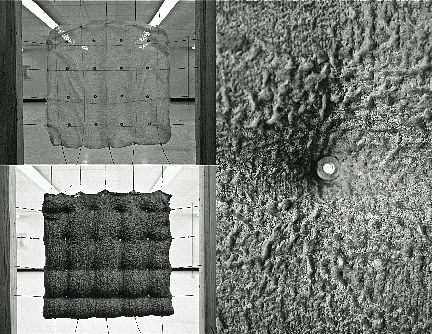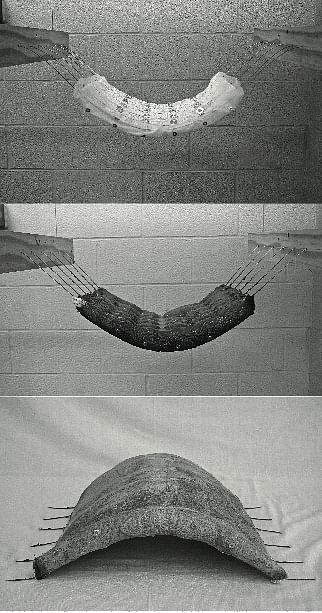
Contributed By: Allison Adderley, M.Arch Student
In conjunction with Faculty Members Christopher Romano and Jean LaMarche
Formwork has often been defined as a temporary building element, typically neglected and rarely interpreted by architects as anything more than a byproduct of construction. However, by reconceptualizing its role as a permanent building component, its construction performance now can be evaluated in parallel with its architectural function. This research reinterprets standard casting conventions as a means of rethinking design parameters, one that considers form and formwork during and after construction as equals in terms of architectural significance.
The separation of the act of construction from the way in which we experience architecture has resulted in a detachment from the fundamental connection to the human act of making. At some point, a division was created, one that drew a line between architect as “thinker” and the builder as “maker.” Semper suggests that the act of making is a defining factor in architectural form and expression, especially a material’s influence over the process of construction. He evaluated this based on two criteria “1.The work as a result of the material service or use that is intended…2. The work as a result of the material used to produce it, as well as the tools and procedures applied.” Here, both form and meaning are conveyed through the understanding of the act of making and the materials and processes engaged with it.
Concrete is by nature impressionable, so the process from which it is created has a direct impact on its form and perception. Whether it is the grain of wood imbedded into the surface of concrete, or apparent softness created from fabric formwork, each creates a visual association with the process of construction. Fiona McLachlan explains in Fabric Formwork, “Its most natural expression, as a product of a process, is part of its appeal.” The natural plasticity of concrete becomes a vehicle by which process is captured in form.
That is perhaps one of the most captivating aspects of concrete, its ability to tell a tale. Yet, we only seem to have half of the story with concrete. We see the affect one material had on the concrete, but what about the affect the concrete had on it? Did the wood swell or shrink, the fabric tear or stretch? And if these materials are to remain permanent, how do we harness that energy in specific and intentional ways?
My work is now focusing on permanently integrating formwork with form. This research provides an alternative to the traditional approach where formwork, in both its construction and deconstruction, is where a majority of time and energy are expelled. With the formwork no longer temporary, the value of the construction process becomes absorbed into the architecture. The research has been an empirical investigation, creating and exploring casting systems as well as challenging conventions. In all cases, the formwork remains a part of the cast, although each in a unique way enabled by the individual process by means of which it was created.

In this investigation, a magnetic form tie system is used, denying any physical connection. Magnetic cubes are imbedded into the wooden forms and when combined with the magnetic rods spacing the forms apart, create a visually untraceable connection. The initial planes of the wooden forms are reduced to an open grid, allowing the form liner and concrete to expand beyond them. This allows the concrete to form around the wood, anchoring it to the cast. As the concrete cures and shrinks, the wooden forms are released by detaching the imbedded magnets from the cast-in rods. A double pour was experimented with in order to test the strength of magnetism in the rods imbedded into the concrete.

Flex Form explores using the plasticity of concrete to generate form, no longer solely relying on formwork. Flexible connections are used to allow formwork to morph under the pressure of the wet concrete. This required the formwork to have a significant flexibility without compromising its structural integrity. The wood forms were broken down into linear elements, incorporating joints into the surface planes and increasing flexibility. The connections are created using tension cables, running internally between the overlapping wooden elements. The formwork becomes restricted under two separate systems. The form liner restricts the movement based on how taught the fabric is sewn to the forms. Concurrently, form ties act to constrain the system by pulling the formwork together, resisting the outward force of the concrete. A pin system acts as a formwork/form tie connection, which makes removal and reattachment of the formwork effortless, requiring no hard connection. The formwork adjusts under the different slump conditions of the concrete, bending under high water to cement ratios and remaining parallel under stiff mixes.

The ambition of this investigation is to reduce the non-essential elements from the casting process by diversifying other conventions. In developing a strategy for eliminating planar elements, the internal reinforcing became an opportunity to perform another role. Rigid reinforcement is reconceived as a suspended cable system, also serving as a structure to hang the fabric mesh. The mesh is dethreaded (75% initial thread count) to allow the concrete to filter through. In addition, the mesh was also soaked in a bonding agent, which was additionally added to the concrete mix, enhancing the chemical bond between the fabric mesh and concrete. Hydraulic cement was used because as it cures, it doesn’t shrink like typical concrete mixtures. During casting, the fabric vanishes into the concrete, leaving the appearance of a suspended mass of wet concrete with no apparent barrier.

The previous model's use of suspension and gravity (concrete displacement) inspired further investigation, which aimed to combine these techniques as a structural strategy. By reorienting the reinforcement (pre-tensioned cables) horizontally, the form deflects into an arch, working with the forces of gravity instead of resisting them, producing a purely compressive structure. The pour location becomes a challenging task however, due to the angle and flexible nature of the mould. To counteract this, multiple pour locations are introduced so that the pressure of the concrete can build from the center outward.
The next phase of the research is a full-scale installation located at the Buffalo Grain Elevators (Silo City: Rick Smith). The installation will explore the opportunities and limitations found within the suspended fabric series. The tensioned defined and gravity-enhanced structures will be hung from the existing, purely compressive concrete silos. The ambition is to let this parasitic process use the existing voids once enabling a very specific sequence of movement to redefine, both functionally and formally, a new type of movement.

For more information, visit www.buildingmatters.wordpress.com
Learn more about the research and creative activities of our enterprising students and faculty. At the School of Architecture and Planning, we engage with our local and global communities to push the boundaries of our disciplines and innovate the professions of architecture and planning.
1 Comment
interesting work.
you might find some inspiration in the work of mark west and his research at CAST at u of manitoba (canada). he has been doing fabric formwork for 20 or more years.
also,if interested in keeping the form work in place as part of design solution it is fairly common to do so with metal lathe. usually that is for underground applications, but my advisor for phd used it for walls of building recently for health care building on the YKK factory campus in toyama (japan).
Block this user
Are you sure you want to block this user and hide all related comments throughout the site?
Archinect
This is your first comment on Archinect. Your comment will be visible once approved.